Update: October, 2014. Change to the identification of Cardiocrinum cathayanum
The major change to my thinking is that I now believe the plants I have been calling Cardiocrinum cathayanum are no such thing and I suggest that they be called Cardiocrinum cathayanum (hort.) pending more information about their actual identity.
The problems of identification
It might be though that all that is needed is to consult the plant descriptions in the Flora of the country concerned; China in the case of C. giganteum and C. cathayanum and Japan for C. cordatum. The problem is that these descriptions were made from plants in the wild and their cultivated cousins may, and do, vary.
To illustrate these variations, the table below lists various parameters of C. giganteum & C. giganteum yunnanense from the "'Flora of China'[1]" together with those observed in cultivation.
| Plant | Parameter | 'Flora of China' | Found in cultivation |
|---|---|---|---|
| C. giganteum | Stem height | up to 3m | up to 4m |
| C. giganteum | No. of flowers | up to 16 | up to 25 |
| C. giganteum yunnanense | Stem height | up to 2m | up to 3.7m |
| C. giganteum yunnanense | No. of flowers | up to 16 | up to 43 |
| C. giganteum yunnanense | Stem colour | Dark green | Some purple |
| C. cathayanum | No. of flowers | up to 5 | 20 |
So there can be no guarantee that an identification can made on the basis of the size of a parameter. As Peter Cox says concerning Herberium specimens, " ... poorly developed plants have often been selected so that they will fit on to one or two herbarium sheets.", [2] and there is also the possibility that the 'Type' description was made on the basis of a few or, perhaps, a single plant which might not actually be typical!
I've left in the entry for C. cathayanum in the above table 'though, as I've said, I think the actual difference between the number of flowers described for the type and those I've seen on my plants is that what I've got isn't cathayanum!
What has to be done is to abstract traits from the type descriptions of the taxa which are,
The taxonomy of the genus
Splitters & lumpers
I don't know who first coined the terms, but it's often stated that taxonomists fall into one of the above groups. Splitters try to name every variation that occurs whilst lumpers try to group together under one name as many variations as possible.
It seems to me that Botanists tend to be lumpers in an attempt to keep the taxonomy of a genus within reasonable bounds whilst gardeners are splitters as we like a name for every variation that we find. My tendency towards splitting will emerge in what follows.
C. giganteum and C. giganteum yunnanense
These are listed a synonyms in 'The Plant List' which derives its data from the 'World Checklist of Selected Plant Families', (WCSPF). However, they have separate entries in the 'Flora of China' where yunnanense is described as a variety of giganteum.
In cultivation, there are distinct and stable differences between the two taxa. The main one is the colour of the flowers which is the distinguishing factor described in the 'Flora of China' [1] .
"C. giganteum v. giganteum: Stem green, 1.5 - 3 m; tepals adaxially streaked with purple, abaxially greenish.
Forests, hillsides; 1200 - 3600 m. Gansu, Guangdong, Guangxi, Guizhou, Henan, Hubei, Hunan, Shaanxi, Sichuan, S Xizang, Yunnan [Bhutan, NE India, Myanmar, Nepal, Sikkim].
C. giganteum v. yunnanense: Stem dark green, 1 - 2 m; tepals adaxially streaked with purple-red, abaxially white.
Forests; 1200 - 3600 m. Gansu, Guangdong, Guangxi; Guizhou, Henan, Hubei, Hunan, Shaanxi, Sichuan, Yunnan [Myanmar]."
There is also the matter of difference in height but, as is shown above, whilst this is a general property of the plants we grow, there is so much overlap that it cannot be considered as a distinguishing feature.
The other difference quoted above, stem colour, is too imprecise to be used for identification.
Other variations that have been reported refer to a purple or dark stem colour [2] and a more gracile form for yunnanense. The former attribute is by no means universal and the latter, whilst true for our plants, may not be so for all.
From the distributions quoted above there is almost complete overlap of the two taxa so it's unlikely that there is a geographical component to the variation.
There is also a report that DNA analysis of the trnL-F gene in the chloroplast can distinguish between giganteum and yunnanense[3].
Therefore, I consider that yunnanense is a variety of giganteum, Cardiocrium giganteum v. yunnanense, mainly distinguished by the colour of its flowers.
This leaves the question of the all-white and all-pink flowered plants.
The flower colour cannot be solely due to genetics as we have seen almost white flowers on offsets, (which are assumed to be genetically identical to the parent), from plants which had 'typical' flowers so it is likely that there is an epigenic factor, possibly activated by exposure to late or extended frosts?
However, it's been reported that hillsides have been seen completely covered in white flowered Cardiocrinum which would suggest that a stable white form can arise. I would suggest that this could be considered as C. giganteum v. yunnanense f. alba but more investigation of such plants is required to confirm that there is a stable form.
As far as I'm aware, the only totally pink flowered Cardiocrinum are the ones grown by Kelly Dodson and Sue Milliken at Far Reaches Farm Nursery. At this time, (2014), it's not known if they will come true from offsets, (likely), or from seed, (less likely). At the moment, these are referred to as a cultivar, (albeit unregistered), C. giganteum v. yunnanense 'Big & Pink', and they are the result of hand-pollination by Kelly & Sue.
C. cordatum and C. cordatum glehnii
The situation here is the same as for giganteum and yunnanense. These are listed a synonyms by WCSPF. However, they have separate entries in the 'Flora of Japan' [4] where glehnii is described as a variety of cordatum.
"Lilium cordatum (Thunb.) Koidz. Hemerocallis cordata Thunb.; L. cordifolium Thunb.; Cardiocrinum cordatum (Thunb.) Makino Ubi-yuri.
Stout glabrous perennial; stems 50 - 100 cm. long, pale green, hollow; leaves loosely whorled on lower half of the stem, long-petioled, oblong-ovate to broadly ovate, cordate, 7 - 10 cm. long, 7 - 15 cm. wide, abruptly acuminate, the upper surface lustrous, pale to vivid green, the veins often variegated, the upper leaves bract-like.
Racemes simple, 3 - 7 cm. long, few-flowered, the bracts narrowly lanceolate, deciduous; flowers horizontal, greenish white, tubular-infundibuliform, 7 - 10 cm. long, the pedicels very short, the tepals narrowly oblanceolate.- July - Aug. Moist woods in lowlands to foothills; Honshu (Kanto Distr. and wesrvv.), Shikoku, Kyushu.
Var. glehnii (F. Schmidt) Wood. Cardiocrinum glehnii (F. Schmidt) Makino; L. glehnii F. Schmidt; C. cordartum var.glehnii (F. Schmidt) Hara O-uba-yuri.
Plants stouter; leaves broadly ovate; flowers often up to 20, on a rather long rachis, 10-15 cm. long. Honshu (n. and centr. distr.), Hokkaido. Sakhalin and s. Kuriles."
Whilst this does recognise glehnii as a variety, the description of the differences are not very definite, (what is 'stouter'?). It does state that glehnii has more flowers than the species, which we find is so, but has them as larger than those of the species which does not match the plants we grow, (C. cordatum average flower length = 140mm, C. cordatum glehnii average = 110mm).
From the few examples we have had flowering, C. cordatum plants average 4 flowers/plant whilst the putative C. cordatum glehnii have 15 flowers/plant. What can be seen in some examples of C. cordatum glehnii is that the flowers are more squat than those of the species l.e. a wider mouth but shorter length.
The best statement of the situation that I've found is this. "The northern populations of C. cordatum, especially in Sakhalin, Kuriles, Hokkaido, and particularly on the Japan sea side of Honshu, Japan are characterized by taller and more robust morphologies of the flowering individuals, with more numerous and larger flowers than other populations, and thus are referred to as a local variety, var. glehnii. (Kawano et al. 27 2004)" [5]
This still describes glehnii flowers as being larger than the species which, as mentioned above, isn't the case for the plants we grow but I agree with the 'taller', 'more robust', 'more numerous flowers'.
Therefore,I consider that glehnii is a variety of cordatum, Cardiocrinum cordatum v. glehnii, mainly distinguished by its larger size and larger number of flowers.
Two other characteristics of the C. cordatum types is that they tend to retain the lower flower bract much longer than any other taxa even though the type description for C. cordatum states that the bracts are deciduous. In fact, bract retention is given as a distinguishing feature of the species by Victoria Matthews.[6] The second factor is that the flowers show some zygomorphism about a horizontal plane, designated by my wife as the 'cordatum hump'.
This leaves us with Cardiocrinum cathayanum
Cardiocrinum cathayanum
The type description of C. cathayanum in The Flora of China is,
"Lilium cathayanum E. H. Wilson, Lilies East. Asia, 99. 1925. Bulbels ca. 2.5 x 1.2 - 1.5 cm. Stem erect, 0.5 - 1.5 m x 2 - 3 cm, hollow.
Leaves absent in proximal part of stem except basal ones, crowded in middle part, laxly spirally alternate in distal part; petiole 6 - 20 cm; leaf blade ovate to ovate - cordate, 10 - 22 x 6 - 12 cm.
Raceme 3-5-flowered; bracts oblong, 4 - 5.5 x ca. 1.6 cm, persistent. Tepals white or greenish, purple streaked adaxially, linear-oblanceolate, 13 - 15 x 1.5 - 2 cm. Stamens 8 - 10 cm, ca. 2/3 as long as tepals; anthers 8 - 9 mm. Ovary 3 - 3.5 cm x 5 - 7 mm. Style 6 - 6.5 cm.
Capsule subglobose, 4 - 5 x 3 - 3.5 cm. Seeds 4.5 - 2.5 mm, reddish brownish winged all round. Fl. Jul - Aug, fr. Aug - Sep. 2 n = 24*.
* Moist and shady places on forested slopes; 600 - 2200 m. Anhui, Fujian, Henan, Hubei, Hunan, Jiangsu, Jiangxi, Zhejiang." [7]
There is no mention of zygomorphism and it refers to bracts, (plural) being persistent but the description is usually accompanied by a drawing which shows only the lower flower bract retained. [8]
The important parts of the above are the height, 0.5 - 1.5m, and the description of the organisation of the leaves.
I would suggest as a modern isotype the plant designated as Kew 2007297. This was compared with Wilson's holotype material in the Kew Herbarium and referred to the Flora of China who confirmed that it was C. cathayanum.
Examining the photos, it can be seen that the leaf distribtion matches the type description. In fact, there appear to be none other than the 'crowded in middle part' group, 'though the plant is starting to die back and possibly some dead leaves can be seen in the 'flower-stem junction' photo. No scale is included but using the flowers as a measure of ~140mm, the height seems to fall into the 0.5 - 1.5 m range. The flowers in the 'Flowers & leaves' picture also show zygomorphism.
As mentioned above, material sold as C. cathayanum which I have bought does not match the type description either in height, number of flowers nor leaf distribution and looks unlike the several on-line photos of C. cathayanum [9].
I've corresponded with several nurseries concerning this and the gist of the matter is that they've accepted the identification given by their suppliers. In some cases, these have been nurseries in China who also seem confused, (see below). I would be certain in my view that the plants aren't cathayanum but for the fact that one nursery got its bulb from Kew!
It is the case that a number of Chinese websites display pictures of plants described as 'C. cathayanum' which match what is sold in the UK but not the type description . i.e. there is also confusion in China. [10]
However, at the moment, I think that they are a dark stemmed, more magenta flowered version C. giganteum yunnanense, but I suggest that they be referred to as Cardiocrinum cathayanum (hort.). I believe this conclusion is supported by the DNA barcodes I've had sequenced for these plants.
The above information has been used to make a key for the identification of the taxa
False indicators
Some other traits have been listed as identifying taxa but these are either incorrect or not stable.
Direction of flower opening
It's been stated that the flowers of C. gig. giganteum open from the bottom of the raceme upwards whilst those of C. gig. yunnanense do so from the top down.
All of our taxa usually open from the bottom up but sometimes from the top down and occasionally from the middle then up and down as shown on the right.
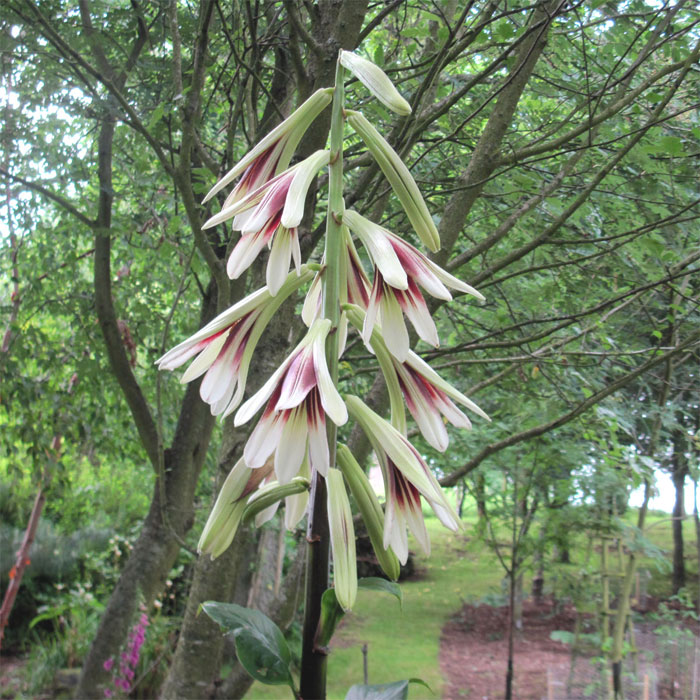
Red veined forms
Several people have described a 'Red veined' form of, usually, C. cordatum.
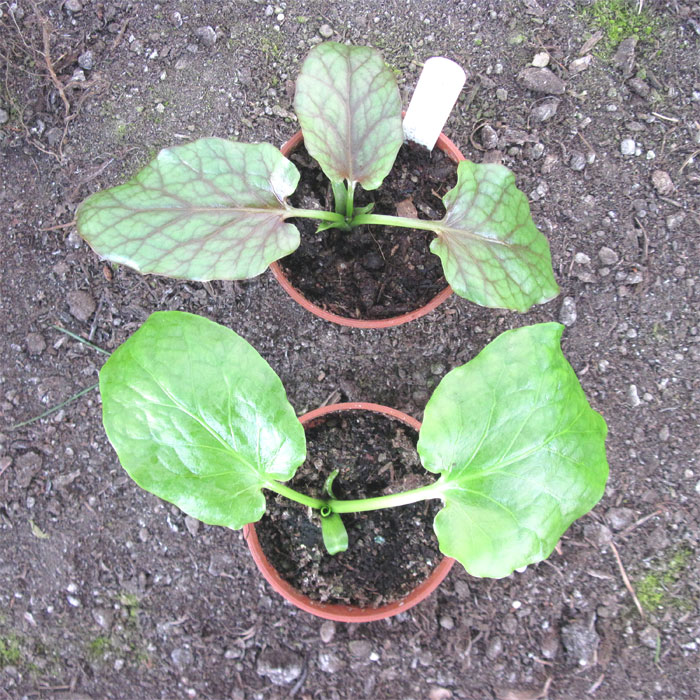
Whilst these do occur, they're not stable and can't be described as a specific form. The seedlings in the picture on the left both came from the same pod of cordatum seeds and the red veining will not necessarily appear on next year's young leaves.
Ratio of leaf length to width
It's been claimed that a leaf blade which is longer than it is broad is an indicator for C. cathayanum.
Whilst there are some exceptions, the majority of my taxa meet this criterion.
My reservations
I've still some resevations on the above suggestions for the following reasons.
C. cathayanum & C. cordatum
I've never seen Cardiocrinum cathayanum and I'll not be happy until I've seen a few plants flower and can judge how stable is the described leaf distribution.
You may have realised from the descriptions above that the leaf distribution on the stem is the only obvious difference between C. cathayanum and C. cordatum. I know from my own plants that, whilst the description of the organisation of the leaves on cordatum is correct, there are quite wide variations between a large rosette at the base of the plant with few other leaves and a spread of leaves up the stem with just a few more at the base.
I think it's possible that if C. cathayanum and C. cordatum grew in the same location they wouldn't be considered as separate species; different varieties at the best, and I have doubts as to just how different they are but this would need genetic analysis to provide definite information and I've started to collect DNA barcode information towards this end.

The plants at the left, photgraphed in Kyoto, are described as C. cordatum, but the organisation of the leaves is typical cathayanum.
I've come across a number of pictures with this arrangement of leaves which are described as C. cordatum!
C. cathayanum grows in the North-East of China.[11] Both the prevailing winds and Ocean currents move from China to Japan and it would not be impossible for it to have colonised Japan if C. cordatum glehnii has reached the Kuriles? Are there similar plants in Korea?
The dates of the type descriptions may be significant, 1925 for C. cathayanum and 1913 for C. cordatum. Sino-Japanese relationships were not good at those times. The pertinent question would be whether E H Wilson was familiar with the type description of C. cordartum when he described cathayanum?
Update, May 2014
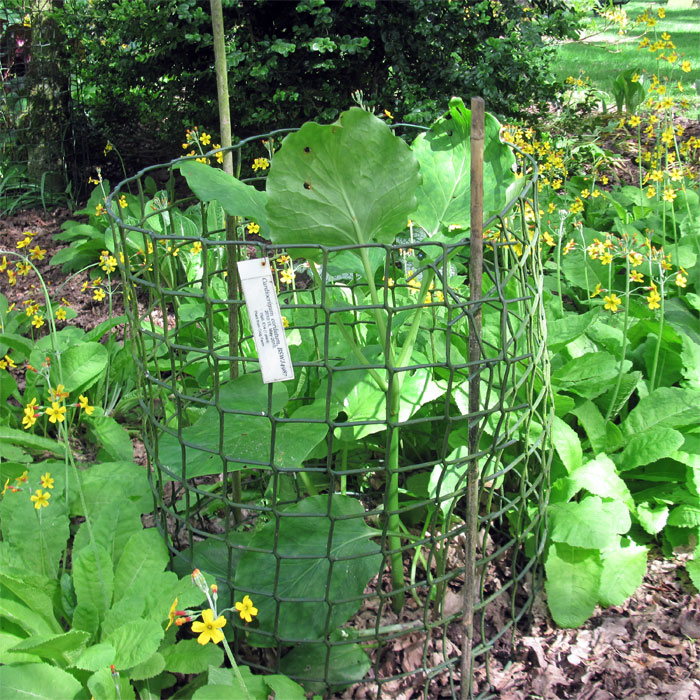
I've found one of my C. cordartum, (15p0), growing with the leaf pattern described above for C. cathayanum.
There are also some C. cordartum glehnii with the same arrangement of leaves. An attempt to quantify the leaf arrangements can be found here.
Update, October 2014
Having looked at the intial DNA barcodes for C. cordartum and at the leaf distributions on this year's plants, I've rejected 'leaf distribution' as a criterion for separating C. cordartum from C. cathayanum, and have altered the taxonomy key accordingly.
Variations in C. cordatum
I have a number of plants which are all labelled as cordatum but which can be split into two groups on the basis of flower colouration.
One group has flowers with a greenish tinge and a minimal amount of magenta: a little in the throat and a dusting at the tips of the petal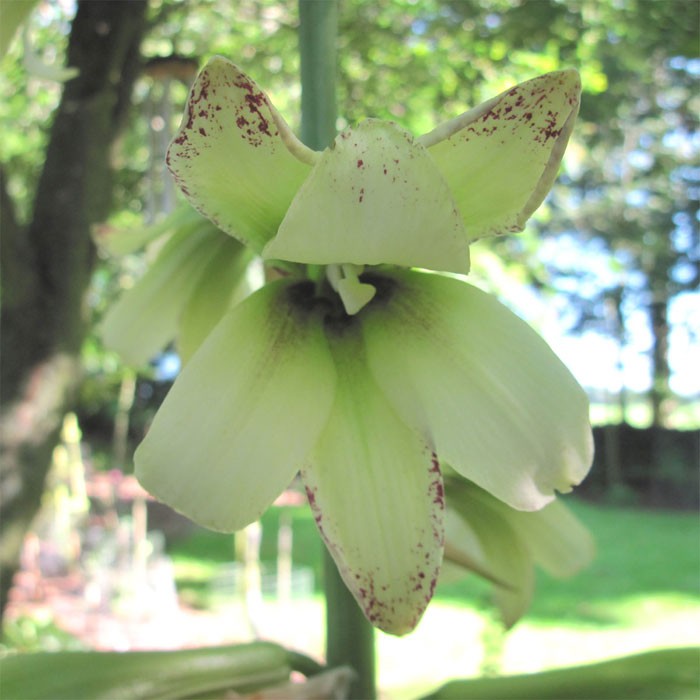
One group has flowers with a greenish tinge and a minimal amount of magenta: a little in the throat and a dusting at the tips of the petals and sepals.
The other group has flowers which are similar to a smaller version of a yunnanense flower: white with faint stripes of magenta.
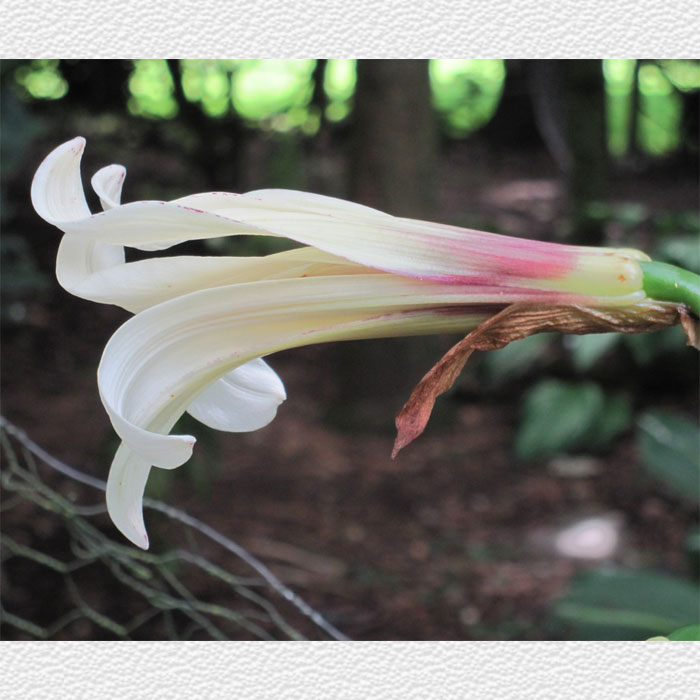
The examples of glehnii which I have, (only two of which have flowered to date), fall into the dusted group.
The question then is whether these differences constitute two different forms of C. cordatum? I think this is where the 'Lumpers' v 'Splitters' comes in! As a gardener, I'd like some way to distinguish these groups but don't think that a taxonomist would agree!